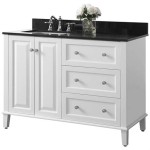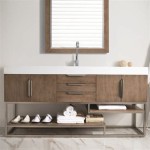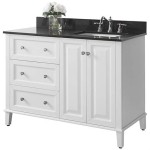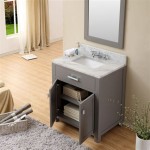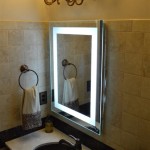Bathroom Vanity Selection: A Comprehensive Guide to 22-Inch Wide Models
The bathroom vanity serves as a pivotal element in bathroom design, offering both functional storage and aesthetic enhancement. When space is limited, a 22-inch wide bathroom vanity presents a practical and efficient solution. This article delves into the intricacies of selecting a 22-inch wide bathroom vanity, covering crucial aspects from material considerations and style options to installation requirements and maintenance tips. This detailed analysis aims to equip readers with the knowledge necessary to make an informed decision when choosing a 22-inch vanity for their bathroom.
The selection of a correctly sized vanity is paramount for bathroom optimization. A vanity that is too large can overwhelm a small space, making it feel cramped and uncomfortable. Conversely, a vanity that is too small may not provide adequate storage, leading to clutter and disorganization. The 22-inch wide vanity strikes a balance, offering a functional surface and storage capacity without sacrificing valuable floor space. This size is particularly well-suited for powder rooms, guest bathrooms, or smaller master bathrooms where space is at a a premium.
Before exploring specific models, a clear understanding of the bathroom's dimensions is essential. Measuring the available space, taking into account door swing, toilet placement, and other fixtures, will help determine if a 22-inch vanity is the optimal size. Consider the overall layout and traffic flow within the bathroom to ensure that the vanity's placement does not impede movement. This pre-planning stage will prevent potential issues during installation and ensure that the chosen vanity integrates seamlessly into the existing space.
Key Point 1: Materials and Construction
The material composition of a bathroom vanity significantly impacts its durability, aesthetics, and resistance to moisture. Bathrooms are inherently humid environments, and the chosen material must be able to withstand prolonged exposure to water and steam. Several common materials are used in the construction of 22-inch wide bathroom vanities, each with its own set of advantages and disadvantages.
Solid wood, such as oak, maple, or birch, offers a classic and timeless appeal. Solid wood vanities are known for their strength and durability. They can be stained or painted to match any design aesthetic. However, solid wood is susceptible to warping and cracking if not properly sealed and maintained. It is crucial to choose kiln-dried wood and to apply a water-resistant finish to protect it from moisture damage. Regular sealing and cleaning are necessary to preserve its longevity and appearance.
Plywood, particularly marine-grade plywood, provides a more stable alternative to solid wood. Plywood is less prone to warping and cracking due to its layered construction. Marine-grade plywood is specifically designed to withstand prolonged exposure to water, making it an excellent choice for bathroom vanities. Plywood vanities can be veneered with wood or laminate for a finished look. The price point is generally lower than solid wood, making it a more budget-friendly option.
Medium-density fiberboard (MDF) is an engineered wood product made from wood fibers, resin, and wax. MDF is smooth and uniform, making it an ideal surface for painting or applying laminate. It is also less expensive than solid wood and plywood. However, MDF is highly susceptible to water damage and should only be used in well-ventilated bathrooms with minimal moisture exposure. MDF vanities require careful sealing and protection to prevent swelling and disintegration from contact with water.
Laminate vanities consist of a thin layer of decorative laminate adhered to a core material, such as particleboard or MDF. Laminate is available in a wide range of colors, patterns, and textures, including wood grain simulations. Laminate is also resistant to scratches, stains, and moisture. However, laminate can chip or peel over time, particularly at the edges and corners. Once the laminate is damaged, it is difficult to repair, which could lead to a shortened lifespan of the vanity.
Metal vanities, often constructed from stainless steel or powder-coated steel, offer a modern and industrial aesthetic. Metal is highly durable and resistant to moisture, making it a practical choice for bathroom environments. Metal vanities are easy to clean and maintain, but they can be prone to dents and scratches. Rusting can also occur if the protective coating is damaged and the metal is exposed to moisture. Careful maintenance, including regular cleaning and rust prevention, is necessary to preserve the appearance of metal vanities.
Cultured marble, granite, and quartz are popular countertop materials that can be integrated into a 22-inch vanity. These materials are durable, water-resistant, and easy to clean. They also offer a luxurious and elegant appearance. However, these materials can be heavy and expensive. Proper support and installation are essential to prevent cracking or damage to the vanity cabinet. The added weight may also make installation more difficult, potentially requiring professional assistance.
Key Point 2: Style and Design Considerations
The style and design of a 22-inch bathroom vanity should complement the overall aesthetic of the bathroom. There is a wide array of styles available, ranging from traditional to contemporary, each offering a unique look and feel. Careful consideration of the existing décor and personal preferences is essential when selecting a vanity style.
Traditional vanities often feature ornate details, such as raised panel doors, decorative moldings, and antique-style hardware. They are typically made from solid wood and finished with a rich stain or paint. Traditional vanities evoke a sense of elegance and sophistication, often drawing inspiration from classic furniture designs. These vanities are well-suited for bathrooms with a traditional or vintage theme.
Contemporary vanities, on the other hand, are characterized by clean lines, minimalist designs, and modern hardware. They are often made from materials such as laminate, glass, or metal. Contemporary vanities offer a sleek and streamlined appearance, perfect for bathrooms with a modern or minimalist aesthetic. The emphasis is on functionality and simplicity, with minimal ornamentation or decorative elements.
Transitional vanities bridge the gap between traditional and contemporary styles. They combine elements of both, such as clean lines with subtle decorative details. Transitional vanities offer a versatile option that can complement a wide range of bathroom styles. They provide a balance between formality and informality, creating a timeless and inviting space.
Floating vanities, also known as wall-mounted vanities, are suspended off the floor, creating a sense of spaciousness and airiness. They are particularly well-suited for small bathrooms, as they maximize floor space and make cleaning easier. Floating vanities offer a modern and minimalist aesthetic and can be customized with various hardware and countertop options. However, proper wall reinforcement is essential to support the weight of the vanity and its contents.
Vanities with integrated sinks offer a seamless and streamlined look. The sink is molded directly into the countertop, eliminating gaps and crevices where dirt and bacteria can accumulate. Integrated sinks are available in a variety of materials, such as cultured marble, acrylic, and solid surface. They offer a clean and modern aesthetic and are easy to clean and maintain.
Vessel sinks sit on top of the vanity countertop, creating a unique and eye-catching focal point. Vessel sinks are available in a wide range of shapes, sizes, and materials, such as glass, ceramic, and metal. They offer a stylish and contemporary look and can add a touch of personality to a bathroom. However, vessel sinks require a taller vanity and may not be suitable for individuals with limited reach or mobility.
The color and finish of the vanity should also be carefully considered. Neutral colors, such as white, gray, and beige, are versatile and timeless. They can complement a wide range of bathroom color schemes and create a sense of calm and serenity. Bold colors, such as blue, green, or red, can add a pop of personality and create a more vibrant and energetic space. Wood finishes, such as oak, maple, and cherry, offer a warm and inviting look. The finish should be durable and water-resistant to withstand the humid bathroom environment.
Key Point 3: Installation and Maintenance
Proper installation is crucial to ensure the longevity and functionality of a 22-inch bathroom vanity. While some individuals may be comfortable with DIY installation, professional installation is often recommended, especially for complex installations or when dealing with plumbing and electrical connections.
Before installation, carefully review the manufacturer's instructions and gather all necessary tools and materials. Ensure that the water supply lines and drainpipes are properly located and accessible. Disconnect the water supply to the existing sink and drain before beginning the removal process. Remove the old vanity carefully, taking care not to damage the surrounding walls or flooring.
Inspect the wall and floor for any damage or imperfections. Repair any cracks, holes, or uneven surfaces before installing the new vanity. Ensure that the wall is level and plumb to prevent the vanity from wobbling or leaning. Use shims to level the vanity if necessary. Secure the vanity to the wall studs using screws or bolts. For floating vanities, ensure that the wall is adequately reinforced to support the weight of the vanity.
Connect the water supply lines to the faucet and the drainpipe to the sink. Check for leaks and tighten any loose connections. Apply sealant around the edges of the vanity and the countertop to prevent water from seeping into the cabinet. Install the hardware, such as knobs, pulls, and hinges. Adjust the doors and drawers to ensure that they open and close smoothly.
Regular maintenance is essential to keep a 22-inch bathroom vanity in good condition. Clean the vanity regularly with a mild soap and water. Avoid using abrasive cleaners or harsh chemicals, as these can damage the finish. Wipe up spills immediately to prevent staining or water damage. Check for leaks regularly and repair any leaks promptly.
Apply a sealant to the countertop periodically to protect it from stains and water damage. Tighten loose screws and hardware as needed. Inspect the plumbing connections regularly and replace any worn or damaged parts. Clean the drain regularly to prevent clogs and maintain proper drainage. By following these maintenance tips, the lifespan of the vanity can be extended and its appearance maintained for years to come.

Bellaterra Home 203146 Bathroom Vanity Dark Espresso White Ceramic Top

Wyndham Gray Bath Vanity Cabinet 22 Inch X 18 ǀ Today S Design House

Home Decorators Collection Ridge 24 In W X 22 D 34 H Bath Vanity Cabinet Without Top White Rg24 Wh The

22 Inch Long Bathroom Vanities Vanity Tops At Com

22 Inch Wide Bathroom Vanities At Com

Home Decorators Collection Ridge 36 In W X 22 D 34 H Bath Vanity Cabinet Without Top White Rg36 Wh The

22 Inch Long Bathroom Vanities Vanity Tops At Com

Bellaterra Home 203146 Bathroom Vanity Dark Espresso White Ceramic Top

22 In W X 12 D 26 H Single Sink Floating Bath Vanity White With Ceramic Top Right Side Storage 200757aak The Home

Wyndham Gray Bath Vanity Cabinet 22 Inch X 18 ǀ Today S Design House



